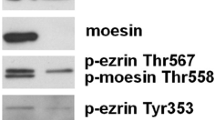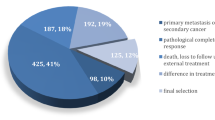Abstract
Purpose
Ezrin is known to be involved in intercellular interactions, and a shift from membrane-bound to cytoplasmatic protein expression has been associated with malignant potential. This association has primarily been demonstrated in cell lines and, as yet, little is known about the distribution of ezrin in primary benign and malignant breast tissues. We have, therefore, set out to investigate ezrin protein expression in a series of primary breast lesions.
Methods
Immunohistochemistry was used to detect ezrin expression in 465 samples of normal breast tissues, benign breast tumours, pre-invasive breast lesions, breast cancer tissues and metastatic lymph nodes, and the protein expression patterns observed were correlated with clinicopathological parameters.
Results
Ezrin was detected in the cytoplasm of both benign and malignant breast tissues, but its expression was significantly higher in the malignant tissues (13 % vs 60 %, p < 0.0001; χ 2 test). We also detected a statistically significant higher ezrin expression in pre-invasive lesions compared to benign lesions (15 % vs 44 %, p = 0.04; χ 2 test). We did not find such a difference in ezrin expression between pre-invasive and invasive cancer samples, nor between invasive cancer samples and lymph node metastases. Within the group of invasive cancer samples, we found a significant correlation between ezrin expression and CK14 (rs:0.38, p < 0.007) and Her2 (rs:0.25, p < 0.002) expression. No such correlation was observed between ezrin expression and nodal status, grading, patient’s age, hormone receptor status, and Ki67 or p53 expression.
Conclusion
Taken together, we found that cytoplasmatic ezrin expression increases from benign to malignant breast tumour development. We hypothesize that the tissue architectural alterations that are associated with aberrant ezrin expression may point at pathophysiological mechanisms that may be instrumental for the design of novel therapies.

Similar content being viewed by others
References
K.A. Swanson, D.D. Crane, H.D. Caldwell, Chlamydia trachomatis species-specific induction of ezrin tyrosine phosphorylation functions in pathogen entry. Infect. Immun. 75, 5669–5677 (2007)
A. Fadiel, H.H. Lee, N. Demir, S. Richman, A. Iwasaki, K. Connell, F. Naftolin, Ezrin is a key element in the human vagina. Maturitas 60, 31–41 (2008)
A. Bretscher, Regulation of cortical structure by the ezrin-radixin-moesin protein family. Curr. Opin. Cell Biol. 11, 109–116 (1999)
S. Tsukita, S. Yonemura, S. Tsukita, ERM (ezrin/radixin/moesin) family: from cytoskeleton to signal transduction. Curr. Opin. Cell Biol. 9, 70–75 (1997)
S. Fais, A role for ezrin in a neglected metastatic tumor function. Trends Mol. Med. 10, 249–250 (2004)
S. Tsukita, K. Oishi, N. Sato, J. Sagara, A. Kawai, S. Tsukita, ERM family members as molecular linkers between the cell surface glycoprotein CD44 and actin-based cytoskeletons. J. Cell Biol. 126, 391–401 (1994)
S. Yonemura, M. Hirao, Y. Doi, N. Takahashi, T. Kondo, S. Tsukita, S. Tsukita, Ezrin/radixin/moesin (ERM) proteins bind to a positively charged amino acid cluster in the juxta-membrane cytoplasmic domain of CD44, CD43, and ICAM-2. J. Cell Biol. 140, 885–895 (1998)
M. Curto, A.I. McClatchey, Ezrin…a metastatic detERMinant? Cancer Cell 5, 113–114 (2004)
D.T. Dransfield, A.J. Bradford, J. Smith, M. Martin, C. Roy, P.H. Mangeat, J.R. Goldenring, Ezrin is a cyclic AMP-dependent protein kinase anchoring protein. EMBO J. 16, 35–43 (1997)
K.W. Hunter, Ezrin, a key component in tumor metastasis. Trends Mol. Med. 10, 201–204 (2004)
X. Yao, L. Cheng, J.G. Forte, Biochemical characterization of ezrin-actin interaction. J. Biol. Chem. 271, 7224–7229 (1996)
P. Pujuguet, L. Del Maestro, A. Gautreau, D. Louvard, M. Arpin, Ezrin regulates E-cadherin-dependent adherens junction assembly through Rac1 activation. Mol. Biol. Cell 14, 2181–2191 (2003)
M. Berryman, Z. Franck, A. Bretscher, Ezrin is concentrated in the apical microvilli of a wide variety of eptihelial cells whereas moesin is found primarily in endothelial cells. J. Cell Sci. 105, 1025–1043 (1993)
A. Gautreau, P. Poullet, D. Louvard, M. Arpin, Ezrin, a plasma memrane- microfilament linker, signals cell survival through the phosphatidylinositol 3- kinase/Akt pahtway. Proc. Natl. Acad. Sci. U. S. A. 96, 7300–7305 (1999)
A.I. McClatchey, Merlin and ERM proteins: unappreciated roles in cancer development? Nat. Rev. Cancer 3, 877–883 (2003)
B. Bruce, G. Khanna, L. Ren, G. Landberg, K. Jirström, C. Powell, A. Borczuk, E.T. Keller, K.J. Wojno, P. Meltzer, K. Baird, A. McClatchey, A. Bretscher, S.M. Hewitt, C. Khanna, Expression of the cytoskeleton linker protein ezrin in human cancers. Clin. Exp. Metastasis 24, 69–78 (2007)
T.A. Martin, G. Harriso, R.E. Mansel, W.G. Jiang, The role of the CD44/ezrin complex in cancer metastasis. Crit. Rev. Oncol. Hematol. 46, 165–186 (2003)
A. Gautreau, D. Louvard, M. Arpin, ERM proteins and NF2 tumor suppressor: the Yin and Yang of cortical actin organization and cell growth signaling. Curr. Opin. Cell Biol. 14, 104–109 (2002)
N. Koon, R. Schneider-Stock, M. Sarlomo-Rikala, J. Lasota, M. Smolkin, G. Petroni, A. Zaika, C. Boltze, F. Meyer, L. Andersson, S. Knuutila, M. Miettinen, W. El-Rifai, Molecular targets for tumour progression in gastrointestinal stromal tumours. Gut 53, 235–240 (2004)
S.C. Kaul, Y. Mitsui, Y. Komatsu, R.R. Reddel, R. Wadhwa, A highly expressed 81kDa protein in immortalized mouse fibroblast: its proliferative function and identity with ezrin. Oncogene 13, 1231–1237 (1996)
Z.Y. Shen, L.Y. Xu, M.H. Chen, E.M. Li, J.T. Li, X.Y. Wu, Y. Zeng, Upregulated expression of Ezrin and invasive phenotype in malignantly transformed esophageal epithelial cells. World J. Gastroenterol. 9, 1182–1186 (2003)
K. Ohtani, H. Sakamoto, T. Rutherford, Z. Chen, K. Satoh, F. Naftolin, Ezrin, a membrane-cytoskeletal linking protein, is involved in the process of invasion of endometrial cancer cells. Cancer Lett. 147, 31–38 (1999)
C. Khanna, J. Khan, P. Nguyen, J. Prehn, J. Caylor, C. Yeung, J. Trepel, P. Meltzer, L. Helman, Metastasis-associated differences in gene expression in a murine model of osteosarcoma. Cancer Res. 61, 3750–3759 (2001)
C. Khanna, X. Wan, S. Bose, R. Cassaday, O. Olomu, A. Mendoza, C. Yeung, R. Gorlic, S.M. Hewitt, L.J. Helman, The membrane-cytoskeleton linker ezrin is necessary for osteosarcoma metastasis. Nat. Med. 10, 182–186 (2004)
S. Ferrari, L. Zanella, M. Alberghini, E. Palmerini, E. Staals, P. Bacchini, Prognostic significance of immunohistochemical expression of ezrin in non-metastatic high-grade osteosarcoma. Pediatr. Blood Cancer 50, 752–756 (2008)
Y. Yu, J. Khan, C. Khanna, L. Helman, P.S. Meltzer, G. Merlino, Expression profiling identifies the cytoskeletal organizer ezrin and the developmental homeoprotein Six-1 as key metastatic regulators. Nat. Med. 10, 175–181 (2004)
N. Akisawa, I. Nishimori, T. Iwamura, S. Onishi, M.A. Hollingsworth, High levels of ezrin expressed by human pancreatic adenocarcinoma cell lines with high metastatic potential. Biochem. Biophys. Res. Commun. 258, 395–400 (1999)
H.J. Wang, J.S. Zhu, Q. Zhang, Q. Sun, H. Guo, High level of ezrin expression in colorectal cancer tissues is closely related to tumor malignancy. World J. Gastroenterol. 15, 2016–2019 (2009)
J. Musiał, S. Sporny, A. Nowicki, Prognostic significance of E-cadherin and ezrin immunohistochemical expression in prostate cancer. Pol. J. Pathol. 58, 235–243 (2007)
S.T. Pang, X. Fang, A. Valdman, G. Norstedt, A. Pousette, L. Egevad, P. Ekman, Expression of ezrin in prostatic intraepithelial neoplasia. Urology 63, 609–612 (2004)
Z. Chen, A. Fadiel, Y. Feng, K. Ohtani, T. Rutherford, F. Naftolin, Ovarian epithelial carcinoma tyrosine phosphorylation, cell proliferation, and ezrin translocation are stimulated by interleukin 1alpha and epidermal growth factor. Cancer 92, 3068–3075 (2001)
K. Ohtani, H. Sakamoto, T. Rutherford, Z. Chen, A. Kikuchi, T. Yamamoto, K. Satoh, F. Naftolin, Ezrin, a membrane-cytoskeletal linking protein, is highly expressed in atypical endometrial hyperplasia and uterine endometrioid adenocarcinoma. Cancer Lett. 179, 79–86 (2002)
B.E. Elliott, J.A. Meens, S.K. SenGupta, D. Louvard, M. Arpin, The membrane cytoskeletal crosslinker ezrin is required for metastasis of breast carcinoma cells. Breast Cancer Res. 7, R365–R373 (2005)
Q. Li, M. Wu, H. Wang, G. Xu, T. Zhu, Y. Zhang, P. Liu, A. Song, C. Gang, Z. Han, J. Zhou, L. Meng, Y. Lu, S. Wang, D. Ma, Ezrin silencing by small hairpin RNA reverses metastatic behaviors of human breast cancer cells. Cancer Lett. 261, 55–63 (2008)
E.D. Coene, C. Gadelha, N. White, A. Malhas, B. Thomas, M. Shaw, D.J. Vaux, A novel role for BRCA1 in regulating breast cancer cell spreading and motility. J. Cell Biol. 192, 497–512 (2011)
D. Sarrio, S.M. Rodriguez-Pinilla, A. Dotor, F. Calero, D. Hardisson, J. Palacios, Abnormal ezrin localization is associated with clinicopathological features in invasive breast carcinomas. Breast Cancer Res. Treat. 98, 71–79 (2006)
A. Halon, P. Donizy, P. Surowiak, R. Matkowski, ERM/Rho protein expression in ductal breast cancer: a 15 year follow-up. Cell. Oncol. (2013, Feb 19).
A.A. Arslan, D. Silvera, R. Arju, S. Giashuddin, I. Belitskaya-Levy, S.C. Formenti, R.J. Schneider, Atypical ezrin localization as a marker of locally advanced breast cancer. Breast Cancer Res. Treat. 134, 981–988 (2012)
J. Moilanen, H. Lassus, A. Leminen, A. Vaheri, R. Butzow, O. Carpen, Ezrin immunoreactivity in relation to survival in serous ovarian carcinoma patients. Gynecol. Oncol. 90, 273–281 (2003)
K.D. Geiger, P. Stoldt, W. Schlote, A. Derouiche, Ezrin immunoreactivity is associated with increasing malignancy of astrocytic tumors but is absent in oligodendrogliomas. Am. J. Pathol. 157, 1785–1793 (2000)
S. Ilmonen, A. Vaheri, S. Asko-Seljavaara, O. Carpen, Ezrin in primary cutaneous melanoma. Mod. Pathol. 2, 1–8 (2004)
S. Zheng, J. Huang, K. Zhou, C. Zhang, Q. Xiang, Z. Tan, T. Wang, X. Fu, 17β-estradiol enhances breast cancer cell motility and invasion via extra-nuclear activation of actin-binding protein ezrin. PLoS ONE 6, e22439 (2011)
L. Ma, X.H. Zhang, L.X. Xing, Y.H. Li, X.L. Wang, Y.J. Wang, Relationship of ezrin protein expression to the carcinogenesis and prognosis of infiltrating breast ductal carcinoma. Zhonghua Zhong Liu Za Zhi 30, 279–283 (2008)
F. Rastelli, S. Biancanelli, A. Falzetta, A. Martignetti, C. Casi, R. Bascioni, L. Giustini, S. Crispino, Triple- negative breast cancer: current state of the art. Tumori 96, 875–888 (2010)
Q. Li, M.F. Wu, A.P. Song, J.C. Wei, G. Xu, Y.P. Lu, D. Ma, Expression of ezrin and e-cadherin in invasive ductal breast cancer and their correlations to lymphatic metastasis. Ai Zheng 25, 363–366 (2006)
L. Ma, Y.P. Liu, X.H. Zhang, C.Z. Geng, Z.H. Li, Relationship of RhoA signaling activity with ezrin expression and ist significance in the prognosis for breast cancer patients. Chin. Med. J. 126, 242–247 (2013)
Conflict of interest
The authors declare that they have no conflict of interest.
Author information
Authors and Affiliations
Corresponding author
Rights and permissions
About this article
Cite this article
Gschwantler-Kaulich, D., Natter, C., Steurer, S. et al. Increase in ezrin expression from benign to malignant breast tumours. Cell Oncol. 36, 485–491 (2013). https://doi.org/10.1007/s13402-013-0153-5
Accepted:
Published:
Issue Date:
DOI: https://doi.org/10.1007/s13402-013-0153-5




